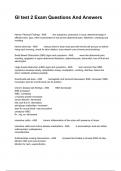GI test 2 Exam Questions And Answers
Hernia: Physical Findings - ANS few symptoms, protrusion or lump, abdominal bulge in
affected area, pain, when incarcerated or has severe abdominal pain, distention, cramping and
vomiting
hernia client edu - ANS instruct client to wear truss pad with hernia belt and put on before
rising each morning, check for skin irritation, truss doesnt cure a hernia avoid straining
Small Bowel Obstruction (SBO) signs and symptoms - ANS wave like abdominal pain,
vomiting, epigastric or upper abdominal distension, abdominal pain, discomfort, loss of fluid and
electrolytes
Large bowel obstruction (LBO) signs and symptoms - ANS less common then SBO,
symptoms develope slowly, dehydration slowly, constipation, vomiting, diarrhea, ribbon like
stool, metabolic acidosis possible
Diverticulitis lab tests - ANS hemaglobin and hemocrit-decreased, ESR- increased, WBC-
increased, stool for occult blood can be positive
Chron's disease lab findings - ANS H&H-decreased
ESR-increased
WBC- increased
c-reactive protein-increased
serum albumin- decreased
folic acid & b12- decreased
anti-glycqn antibodies- increased
stool for occult blood- may be positive
urinalysis- WBC
K+, mg, ca- decreased
ulcerative colitis - ANS chronic inflammation of the colon with presence of ulcers
ulcerative colitis and crohns disease medications - ANS 5 aminosailcylic acid:anti inflam.
sulfonamides: sulfasalazine
nonsulfamides
Sulfonamides nursing interventions - ANS Increase fluid intake to at least 2000 mL/day.
Monitor CBC and renal function.
Monitor for rash, superinfection.
, Avoid during third trimester.
Avoid antacids.
client edu for sulfonamides - ANS take med with full glass of water after meals, avoid sun
exposure, increase fluid intake to 2L/day, can cause urine, skin and contact lenses to yellow,
notify provider if nausea, vomiting, anorexia, sore throat, rash, bruising, or fever occur
ulcerative colitis expected findings - ANS abdominal pain/cramping often LLQ pain,
anorexia and weight loss
ulcerative colitis physical findings - ANS fever, diarrhea up to 20 liquid stools per day, stool
contains mucus blood or pus, high pitched bowel sound, rectal bleeding
Cholecystitis expected findings - ANS sharp pain RUQ radiating to R shoulder, pain when
deep inspiration, intense pain, dyspepsia, eructation, gas, fever, nausea, vomiting
cholecystectomy - ANS surgical removal of the gallbladder
cholecystectomy laparoscopic approach - ANS provide immediate post of care, ambulant,.
monitor incision, talk about pain control, activities are often resumed after 1 week?, report
indications of bile leak-pain, vomiting, abdominal discomfort
cholecystectomy care - ANS report absence of draining, with manifestations, inspect
surrounding skin for evidence of infection or bile leak, monitor color and amount of bile, clamp
the tube 1 hr before and after meals, monitor stool color (clay color until biliary flow is
reestablished), monitor bile peritonitis (pain, fever, jaundice), expect removal of tube 1-3 weeks,
empty drainage bag every 8 hr or as prescribed.
Cullen's sign - ANS ecchymosis in umbilical area (seen with pancreatitis)
Pancreatitis lab tests - ANS Serum amylase and lipase increased, WBC increased,
platelets decreased, calcium and magnesium decreased, glucose increased
Pancreatitis expected Findings - ANS sudden onset of severe boring pain (goes through
body), epigastric,radiating to back, left flank, shoulder, worse when lying down, nausea,
vomiting, weight loss, anorexia. respirations are shallow as pt tried to splint painful area
Pancreatitis nursing care - ANS * Pancreatitis patients but them in fetal position, NPO, gut
rest, prepare antecubital site for PICC
cuz they'll probably be getting TPN/Lipids, nasogastric tube
what do you monitor for TPN - ANS blood glucose




